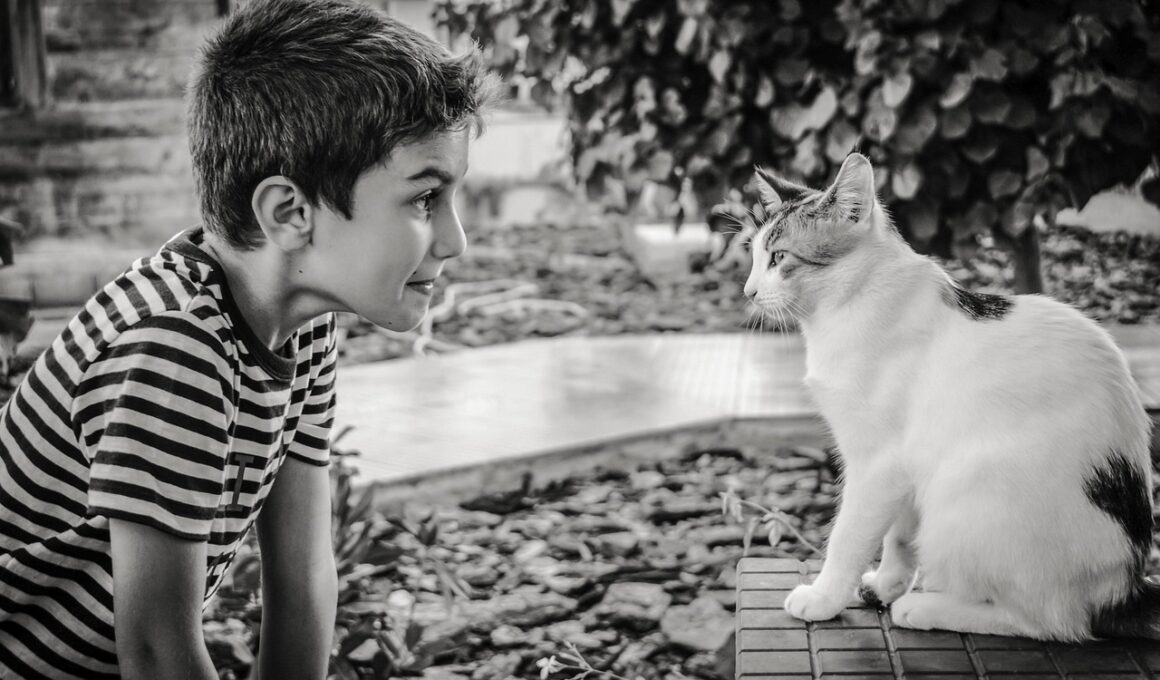Understanding Cat Communication: The Basics
Understanding how cats communicate is vital for their well-being and our relationship with them. Cats possess a range of communicative methods, utilizing vocalizations, body language, and scent marking to express their needs and emotions. Observing these signals closely can provide insights into their feelings and intentions. Vocalization plays an essential role in feline communication, with various sounds indicating different emotions. For instance, a content cat might purr while a distressed one could hiss or yowl. Each sound carries a specific meaning that we must learn to interpret. Beyond sounds, cats also communicate through their body language, such as tail position, ear orientation, and posture. An upright tail often signals happiness, while flattened ears might indicate fear or aggression. Furthermore, scent marking is another sophisticated method of communication in cats. They have scent glands in their cheeks and paws, which they use to leave their scent on objects, marking their territory or expressing comfort in their environment. Knowing these communication methods allows owners to provide better care and support for their feline companions, enhancing the bond we share with our beloved cats.
Vocalization is one of the most noticeable forms of cat communication. Cats use a range of sounds to express different feelings and desires. For instance, a soft meow can signify a request for attention or food, while a loud yowl may signal distress or frustration. Understanding these vocal cues is crucial for meeting their needs effectively. Occasionally, certain cats may develop unique sounds or vocalizations specific to their human family, highlighting the personalized nature of cat communication. Additionally, the pitch and tone of their meows can vary based on the urgency of their message. Recognizing these subtleties can significantly improve interactions between cats and their owners. Besides vocalization, cats also express themselves through their body language. A cat’s posture can reveal a lot; a relaxed cat may stretch out and knead, while an anxious one might crouch low or twitch its tail. The positioning of their ears is a telltale sign of their mood as well. Understanding these physical signals enhances our ability to respond appropriately, fostering a harmonious environment for both the owner and the cat. Learning these cues ultimately strengthens the human-feline bond.
The Role of Body Language in Cat Communication
Body language is an integral aspect of how cats communicate with each other and with humans. By understanding their physical signals, owners can gain valuable insights into their cats’ emotions and needs. For instance, a cat with an upright, relaxed tail demonstrates a friendly atmosphere and a willingness to engage. Conversely, a puffed-up tail signals fear or aggression, serving as a warning to retreat. Ears also play an essential role in body language; ears held upright indicate curiosity, while flattened ears indicate stress or annoyance. Your cat’s whiskers can also offer clues about their state of mind. When whiskers are forward, the cat is likely excited or curious, but whiskers pulled back suggest anxiety or discomfort. Cats may also communicate through their eyes, using slow blinks to express trust and affection. Additionally, subtle behaviors such as licking their lips or adjusting their position can convey their feelings about the environment or the actions of those around them. Observing these body language signals is key to understanding how to interact with your feline friend and ensuring that they feel safe and content in their surroundings.
Scent marking is another crucial method cats use to communicate. Through scent, they convey messages related to territory, mating status, and social relationships. Cats have scent glands located in various areas of their bodies, including their cheeks, paws, and the base of their tail. When a cat rubs its face against furniture or a person, it is leaving its scent to mark its territory, claiming ownership of that space. This behavior also serves to comfort the cat, as familiar scents create a sense of security. Cats may also scratch surfaces to both leave their scent and sharpen their claws. Understanding scent marking can help owners recognize when a cat is feeling anxious about their environment. Additionally, it’s important to note that cats use urine marking as a more potent form of scent communication. When cats urinate outside their litter box, it often signifies stress or territorial disputes. Owners should address the underlying causes of such behaviors to improve their cat’s overall well-being. Recognizing the significance of scent communication aids in fostering a happier home for both cats and their owners.
Understanding Your Cat’s Unique Communication Style
Every cat has its own unique communication style, influenced by factors such as their breed, life experiences, and individual temperament. Some breeds are naturally more vocal and prone to chatter, while others may prefer quieter, more subtle methods of communication. This variation highlights the importance of getting to know your cat personally to recognize what is normal behavior for them. For instance, a Siamese cat might be more inclined to meow persistently compared to a British Shorthair, which may communicate with fewer vocal sounds. Additionally, a cat that has had positive experiences with people is likely to be more expressive and open in its behaviors than a cat that has experienced stress or trauma. Adapting to your cat’s communication style can foster a better relationship and deepen mutual understanding. Observing your cat closely during different interactions can provide meaningful insights into their well-being. Furthermore, documenting these patterns can help identify potential changes in behavior, suggesting shifts in mood or health. By understanding your cat’s unique communication nuances, you create a foundation for a loving and responsive home environment.
It’s essential to remember that communication methods are not universally applicable. Each cat develops its own unique way of communicating based on its environment and past experiences. For instance, a cat raised in a bustling household may vocalize more than a cat raised in solitude. Understanding these individual differences is vital for fostering a positive relationship. Moreover, cats may adjust their communication based on their owners’ responses. If a cat discovers that a specific meow results in attention, it may repeat that sound more frequently. This trial-and-error communication showcases the bond and understanding developed between humans and their feline companions. Moreover, environmental factors, such as the presence of other pets, can impact how a cat communicates. Cats may adopt different behaviors when cohabitating with other animals or during stressful situations, like moving to a new home. Recognizing these situational influences can empower owners to better respond to their cats. By appreciating the individual styles of communication, owners can create an enriched environment that accommodates their cat’s needs and enhances their well-being in return.
Practical Tips for Enhancing Communication with Your Cat
Improving communication with your cat can significantly enhance your relationship and increase understanding between you both. Start by observing your cat’s body language and vocalizations carefully. Note how they signal their needs when they want to eat, play, or seek attention. Establishing a consistent routine in feeding and playtime can help your cat feel secure and minimize anxiety. You can enhance verbal communication by associating specific commands or phrases with actions, like saying “dinner” when feeding. Additionally, engaging in interactive playtime can create deeper bonds as your cat becomes familiar with your cues and reactions. Providing a safe space for your cat is also crucial; ensuring they have a cozy, enriching environment encourages them to communicate their feelings openly. Spend quality time sitting near your cat without overwhelming them, as this allows them to approach you when they feel comfortable. Furthermore, understanding and respecting your cat’s boundaries is vital. The more attuned you become to their unique communication methods, the stronger your bond will grow over time, making for a happier and healthier relationship.
In conclusion, being attuned to cat communication methods enriches the relationship between owner and cat. Understanding the nuances of feline communication through vocalizations, body language, and scent marking can greatly enhance the bond with your furry companion. By recognizing their unique methods of communication, owners can better address their cats’ needs, ensuring they feel secure and loved in their environment. Educating ourselves about our cats’ communication behaviors allows us to respond effectively, fostering an atmosphere of trust and comfort. Observing interactions and identifying patterns can also aid in detecting changes in mood or health, making it easier to provide appropriate support when necessary. Each cat has its own personality and communication style, which develops from their experiences and environment. By respecting these variations, pet owners create nurturing relationships built on understanding and mutual respect. With a little patience and attention, any owner can learn how their feline friend expresses itself and build a more enriching relationship with their beloved pet. Ultimately, learning to communicate effectively with cats deepens the connection and results in a happier, healthier companionship for both parties.


